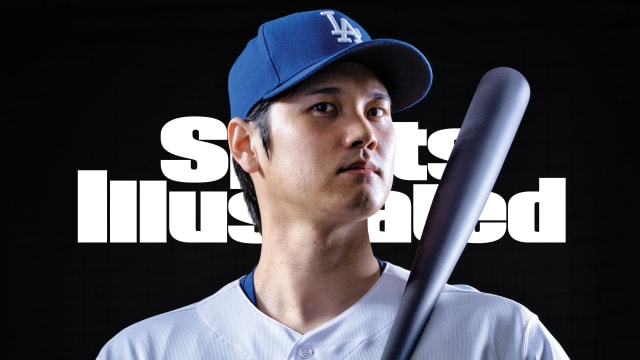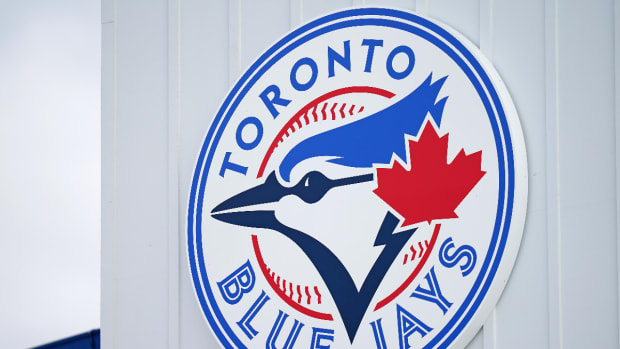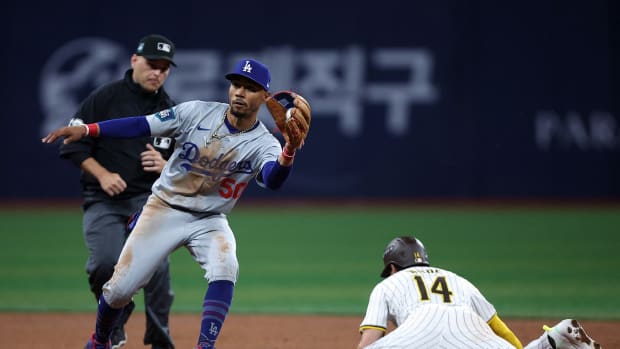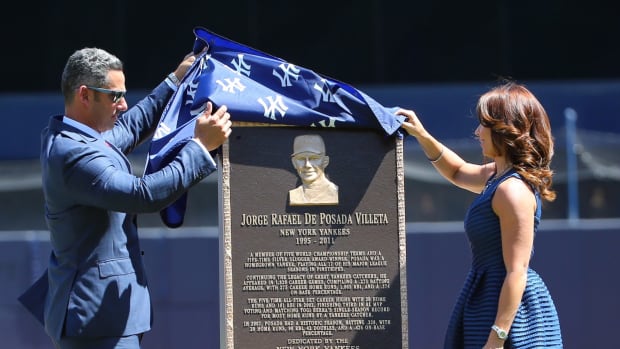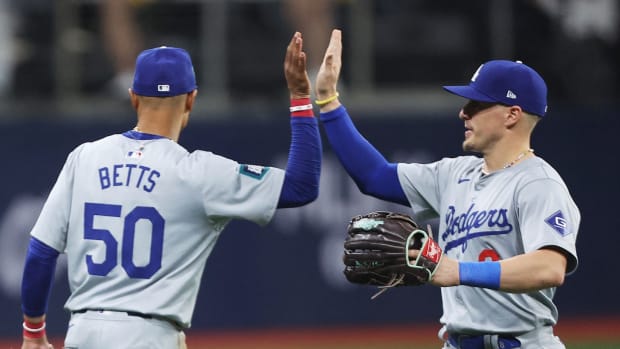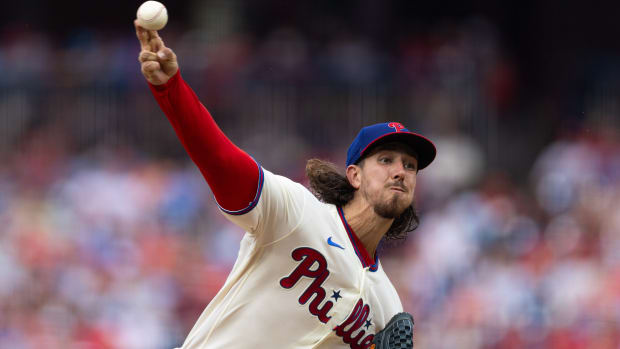Gunnar Henderson Is Ready to Power a New Glorious Era of Orioles Baseball
You can almost hear the clock ticking. Baltimore Orioles shortstop Gunnar Henderson gets better by the day—and more expensive.
It is nine in the morning at Orioles camp in Sarasota, Fla., and Henderson is taking groundballs on the half diamond known as Earl Weaver Field. No other players are around. Some are happily ensconced in the clubhouse, perhaps even enjoying a game of billiards. Five Orioles staff members are with Henderson.
“Taking groundballs” does not do justice to the exercise. Everything is done at game speed. One of the coaches, José Hernández, does not hit fungoes but instead takes full swings at baseballs tossed to him, the better to replicate how a ball reacts off a bat in a game. To field the balls, Henderson must move forward, to the forehand, to the backhand or hold his ground on smashes directly to him. Every throw he makes is game speed, as if a plus runner has hit the grounder. Wearing spikes, Henderson puts in about 15 minutes of non-stop, game-speed work. His day has just begun.
“Man,” he says, wiping the sweat from his face, “I swear it gets hotter every day here.”
It is a small window into the player Henderson is, but it is another example of why the Orioles, under the new leadership of owner David Rubenstein, need to lock up Henderson to a contract extension ASAP, like how the Kansas City Royals took care of Bobby Witt Jr. (11 years, $288.8 million). Henderson is 22 years old, and is such a baseball rat he learned the game on a baseball field carved into the family’s Selma, Ala., backyard and honed his swing in a backyard barn he converted into a state-of-the-art batting tunnel.
He is one of only two players to hit 28 home runs as a rookie at age 22 or younger; the other is Cal Ripken. He is one of only two players with 30 homers and double digits in stolen bases and triples through 184 career games by age 22. The other is Bryce Harper.
Here’s what all that means: you don’t worry about locking up Gunnar Henderson. Few players in the game’s history are this good this young, especially those who can play middle infield at 6’3” and 200 lbs. They become big-time stars.
Oh, wait. Did I mention he added nine pounds since he was the unanimous American League Rookie of the Year last season?
“I didn’t even try,” he says, “but yeah, it’s part of naturally growing and getting bigger and filling out. But the body feels good. I feel mobile. I feel lots of strength. It’s awesome.”
Henderson doesn’t turn 23 until June. With his work ethic, athleticism and dedication, Henderson is exactly the type of player you identify as a franchise player and save money by locking him up, especially a club looking to move past the penurious ways of former controlling owner Peter Angelos. And yet ...
“I have not heard a word,” Henderson says when I ask him about extension talks.
Is that even on your radar, I ask?
“I mean, I’ll look at any offer that they might have,” he says. “But until that happens, I’m just going to go out there and try to play the best I can. Not a single word yet on that.”
Nit-pick if you want. Henderson could improve against lefthanded pitching (.210/.293/.324). He may move to third base if top prospect Jackson Holliday is the better defender at shortstop (though Henderson has the better arm, which could push Holliday to second base). What matters is Henderson is a plug-and-play star who is so determined to get better you don’t dare bet against it. After an OPS of just .702 entering June last season, Henderson posted a .856 OPS over his final 100 games.
“There’s a lot of room to improve,” he says. “I feel like there were a lot of things I could have done better, a lot of room to grow. For me, honestly, it’s getting the experience because that was my first true season. I didn’t really grasp how long it actually is, you know? Just embracing the ups and downs of the season.
“That experience is going to be huge for me. Just taking it into this year.”
I ask him if he felt the “rookie wall” many first-year players experience in August, when the physical and mental grind of the major league season starts to exact its toll.
“No, I felt like I did a good job monitoring my workloads per day,” he says. “Days that I felt good I could take a few extra swings and other days I would just do my pre-game work and that was it. No BP or anything. I felt like I did a good job of that.
“Early in the year I was kind of just go, go, go because I was kind of struggling a little bit. I mean, that’s just how I roll. I want to work more whenever I struggle, so sometimes less is more. But yeah, I felt like I did a good job of that and I’ll kind of use it now in spring training on days where I’m kind of like, ‘Ah, I’ll just do my cage work and just take it home.’”
Henderson’s skill set is extraordinarily complete.
Hitting the baseball hard? Check. He was one of only 24 players with an average exit velocity last season of at least 92 mph—and he was the youngest in that elite group.
Running the bases well? Check. StatCast rated him as the top baserunner in the game.
Arm strength? Check. He had the third strongest arm at shortstop (minimum 200 throws), behind only Elly De La Cruz of the Cincinnati Reds and Masyn Winn of the St. Louis Cardinals. So, did he specifically target something this offseason to improve?
“Yeah, honestly, just to keep trusting,” he says. “I feel like the biggest thing when I got in trouble is when mentally I tried to do too much rather than just sticking to my approach and letting that go.
“And then, I guess as far as the actual swing, honestly, just keep honing in against both [lefties and righties], keep seeing different pitches, different pitch shapes and I feel like we’ve got a good system here.”
With the Orioles and in his cage back home, Henderson likes to hit lighter foam balls fired at plus velocity from a pitching machine from about 50 feet. Because the balls are lighter, they move more than standard baseballs—and they also don’t punish a hitter’s hands when contact is not on the barrel.
“It over exaggerates movement,” he explains. “I’ll do that and then hit normal baseballs. I’ve done that since 2020 and I’ve done it every offseason.”
He uses the same hitting coach back home as he always has: his dad, Allen.
“It’s just been my dad,” he says. “We don’t have too much in Selma, so growing up that’s who helped me. And as I’ve gotten older, I’ll get some feedback from the guys here, but in the offseason it’s just usually myself and my dad.”
The Orioles were 101–61 last season, including 30–16 in one-run games. They are no fluke. In Henderson, Holliday and catcher Adley Rutschman, they have three franchise-type talents coming along at the same time. They have the athleticism, youth and positional versatility that wins in this new era of no shifts and more stolen bases. This year they also have Corbin Burnes, a true ace, anchoring the rotation.
Henderson could be the biggest star of them all. Only three other 22-and-under shortstops reached 30 homers and 10 steals in their first 184 games: Alex Rodriguez, Fernando Tatís Jr. and Carlos Correa. But if you’re an Orioles fan, the preferred comp is Ripken, whose Rookie of the Year season (28 homers, 284 total bases, .792 OPS) looks eerily similar to the one Henderson had (28 homers, 274 total bases, .814 OPS). And every Orioles fan knows how the next year turned out for Cal and Baltimore: an MVP season and a World Series championship, the last time the Orioles won it all.

































